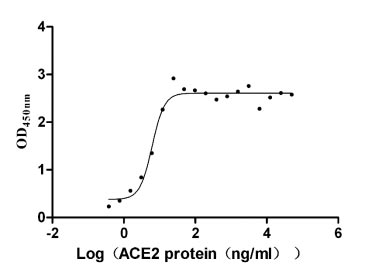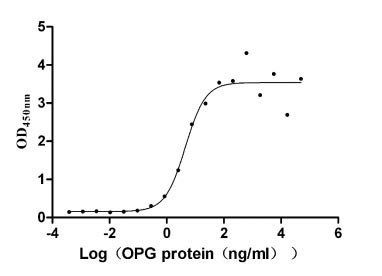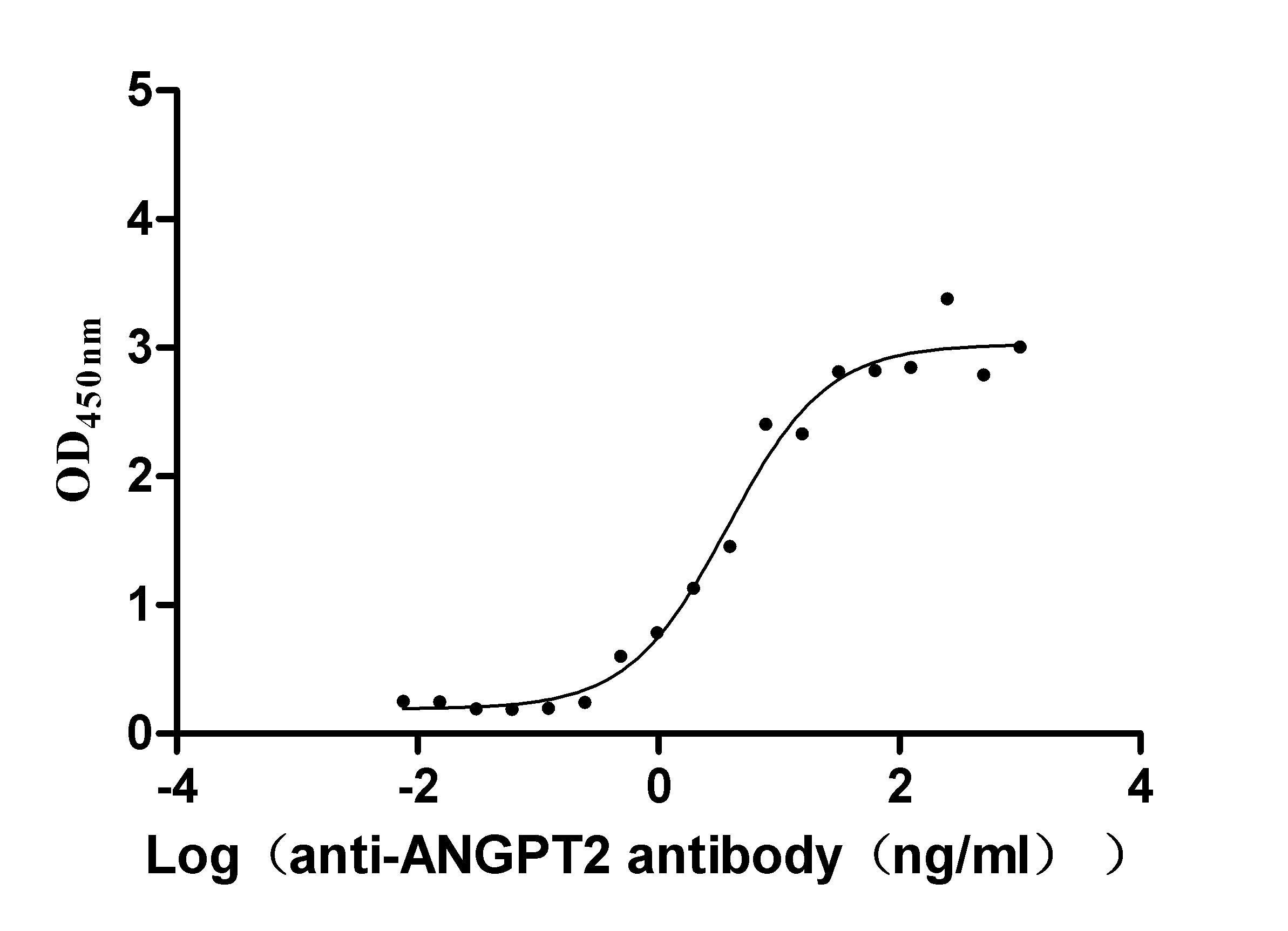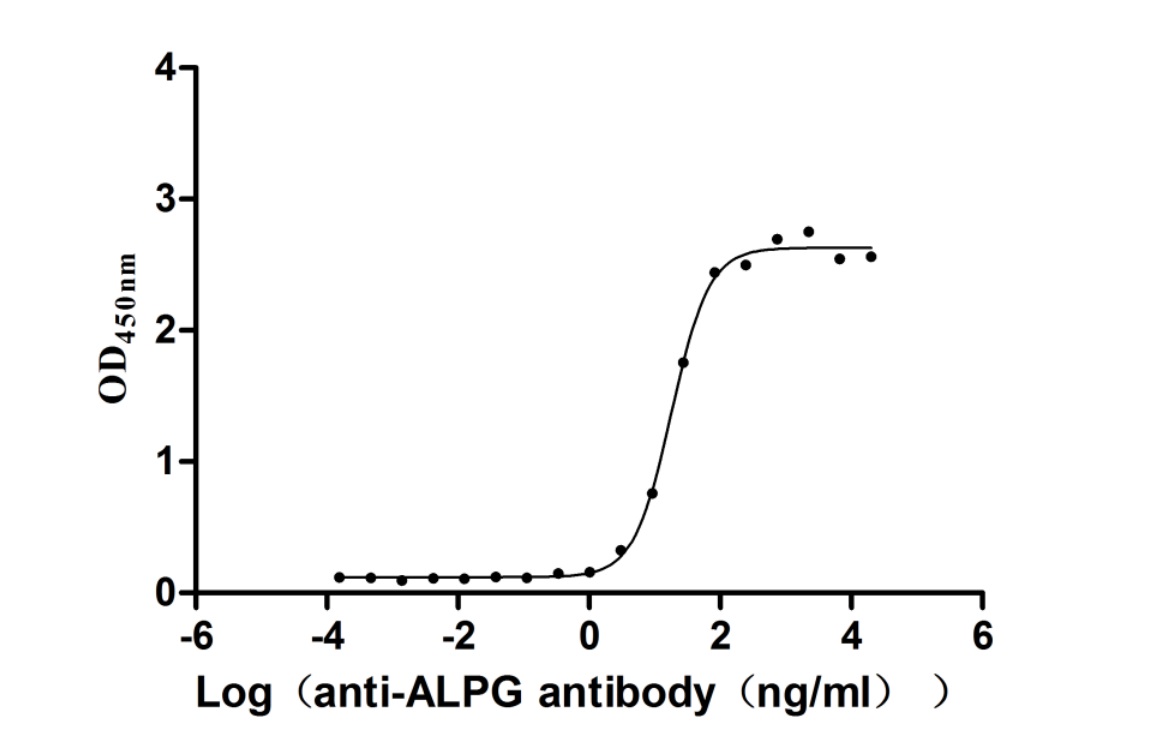Recombinant Human Tubby-related protein 1 (TULP1)
-
中文名稱:人TULP1重組蛋白
-
貨號:CSB-EP025346HU-B
-
說明書:
-
規格:
-
來源:E.coli
-
共軛:Avi-tag Biotinylated
E. coli biotin ligase (BirA) is highly specific in covalently attaching biotin to the 15 amino acid AviTag peptide. This recombinant protein was biotinylated in vivo by AviTag-BirA technology, which method is BriA catalyzes amide linkage between the biotin and the specific lysine of the AviTag.
-
其他:
產品詳情
-
純度:>85% (SDS-PAGE)
-
基因名:TULP1
-
Uniprot No.:
-
別名:RP14; Tubby like protein 1; Tubby related protein 1 (Tubby like protein 1); Tubby related protein 1; Tubby-like protein 1; Tubby-related protein 1; TUBL1; TULP 1; Tulp1; TULP1_HUMAN
-
種屬:Homo sapiens (Human)
-
蛋白長度:Full length protein
-
表達區域:1-542aa
-
氨基酸序列MPLRDETLREVWASDSGHEEESLSPEAPRRPKQRPAPAQRLRKKRTEAPESPCPTGSKPRKPGAGRTGRPREEPSPDPAQARAPQTVYARFLRDPEAKKRDPRETFLVARAPDAEDEEEEEEEDEEDEEEEAEEKKEKILLPPKKPLREKSSADLKERRAKAQGPRGDLGSPDPPPKPLRVRNKEAPAGEGTKMRKTKKKGSGEADKDPSGSPASARKSPAAMFLVGEGSPDKKALKKKGTPKGARKEEEEEEEAATVIKKSNQKGKAKGKGKKKAKEERAPSPPVEVDEPREFVLRPAPQGRTVRCRLTRDKKGMDRGMYPSYFLHLDTEKKVFLLAGRKRKRSKTANYLISIDPTNLSRGGENFIGKLRSNLLGNRFTVFDNGQNPQRGYSTNVASLRQELAAVIYETNVLGFRGPRRMTVIIPGMSAENERVPIRPRNASDGLLVRWQNKTLESLIELHNKPPVWNDDSGSYTLNFQGRVTQASVKNFQIVHADDPDYIVLQFGRVAEDAFTLDYRYPLCALQAFAIALSSFDGKLACE
-
蛋白標簽:Tag?type?will?be?determined?during?the?manufacturing?process.
The tag type will be determined during production process. If you have specified tag type, please tell us and we will develop the specified tag preferentially. -
產品提供形式:Lyophilized powder
Note: We will preferentially ship the format that we have in stock, however, if you have any special requirement for the format, please remark your requirement when placing the order, we will prepare according to your demand. -
復溶:We recommend that this vial be briefly centrifuged prior to opening to bring the contents to the bottom. Please reconstitute protein in deionized sterile water to a concentration of 0.1-1.0 mg/mL.We recommend to add 5-50% of glycerol (final concentration) and aliquot for long-term storage at -20℃/-80℃. Our default final concentration of glycerol is 50%. Customers could use it as reference.
-
儲存條件:Store at -20°C/-80°C upon receipt, aliquoting is necessary for mutiple use. Avoid repeated freeze-thaw cycles.
-
保質期:The shelf life is related to many factors, storage state, buffer ingredients, storage temperature and the stability of the protein itself.
Generally, the shelf life of liquid form is 6 months at -20°C/-80°C. The shelf life of lyophilized form is 12 months at -20°C/-80°C. -
貨期:Delivery time may differ from different purchasing way or location, please kindly consult your local distributors for specific delivery time.Note: All of our proteins are default shipped with normal blue ice packs, if you request to ship with dry ice, please communicate with us in advance and extra fees will be charged.
-
注意事項:Repeated freezing and thawing is not recommended. Store working aliquots at 4°C for up to one week.
-
Datasheet :Please contact us to get it.
相關產品
靶點詳情
-
功能:Required for normal development of photoreceptor synapses. Required for normal photoreceptor function and for long-term survival of photoreceptor cells. Interacts with cytoskeleton proteins and may play a role in protein transport in photoreceptor cells. Binds lipids, especially phosphatidylinositol 3-phosphate, phosphatidylinositol 4-phosphate, phosphatidylinositol 5-phosphate, phosphatidylinositol 3,4-bisphosphate, phosphatidylinositol 4,5-bisphosphate, phosphatidylinositol 3,4,5-bisphosphate, phosphatidylserine and phosphatidic acid (in vitro). Contribute to stimulation of phagocytosis of apoptotic retinal pigment epithelium (RPE) cells and macrophages.
-
基因功能參考文獻:
- Pathogenic mutations in TULP1 are responsible for the retinitis pigmentosa phenotype in seven familial cases with a common ancestral mutation responsible for the disease phenotype in four of the seven families. PMID: 27440997
- photoreceptor degeneration caused by missense mutations via endoplasmic reticulum unfolded protein response PMID: 26987071
- This study highlights the value of the broad sequencing strategy of exome sequencing for disease gene identification in Leber congenital amaurosis, over other existing methods. PMID: 24547928
- Data suggest that mutant tubby like protein 1 (TULP1) proteins are misfolded and accumulate within the endoplasmic reticulum (ER) leading to induction of the unfolded protein response (UPR) stress response complex. PMID: 26427415
- The TULP1 allele p.Gln301* represents a founder mutation on the Arabian Peninsula and is associated with a recognisable congenital recessive rod-cone dystrophy phenotype in the homozygous state. PMID: 25342276
- Retinal degeneration with TULP1 mutations leads to a small central island of residual foveal cones at early ages which are less sensitive than expected from the residual structure. PMID: 25074776
- Maternal uniparental isodisomy of chromosome 6 unmasked a mutation in the TULP1 gene as a novel cause of cone dysfunction. PMID: 23499059
- The single nucleotide polymorphisms rs4374383 and rs9380516 were linked to the functionally related genes MERTK and TULP1, which encode factors involved in phagocytosis of apoptotic cells by macrophages. PMID: 22841784
- One recurrent (c.1138A>G; p.Thr380Ala) and one novel (c.1445G>A; p.Arg482Gln) mutations in TULP1 have been identified in Pakistani families with early-onset retinitis pigmentosa. PMID: 22665969
- Homozygous autosomal recessive retinitis pigmentosa-causing mutations have been found in three Indian families. These included a missense mutation in TULP1. PMID: 22605927
- Pathogenic mutations in TULP1 are responsible for the autosomal recessive retinitis pigmentosa phenotype in these consanguineous Pakistani families, with a single ancestral mutation in TULP1 causing the disease phenotype in 4 of 5 families. PMID: 21987678
- The affected members of the Surinamese family have a severe early-onset form of autosomal recessive retinitis pigmentosa, which is caused by compound heterozygous mutations in the TULP1 gene. PMID: 17620573
- Mutation in the TULP1 gene is a rare cause of LCA/EORD (Leber congenital amaurosis or early-onset retinal degeneration. PMID: 17962469
- A novel splice-site mutation of TULP1, c.1495+2_1495+3insT, underlying autosomal recessive early-onset RP in a consanguineous Israeli Muslim Arab family. PMID: 18432314
顯示更多
收起更多
-
相關疾病:Retinitis pigmentosa 14 (RP14); Leber congenital amaurosis 15 (LCA15)
-
亞細胞定位:Cytoplasm. Cell membrane; Peripheral membrane protein; Cytoplasmic side. Secreted. Cell junction, synapse.
-
蛋白家族:TUB family
-
組織特異性:Retina-specific.
-
數據庫鏈接:
Most popular with customers
-
Recombinant Paguma larvata Angiotensin-converting enzyme 2 (ACE2), partial (Active)
Express system: Mammalian cell
Species: Paguma larvata (Masked palm civet)
-
Recombinant Human Tumor necrosis factor receptor superfamily member 11B (TNFRSF11B) (Active)
Express system: Mammalian cell
Species: Homo sapiens (Human)
-
Recombinant Dog Angiopoietin-2 (ANGPT2) (Active)
Express system: Mammalian cell
Species: Canis lupus familiaris (Dog) (Canis familiaris)
-
Recombinant Human Alkaline phosphatase, germ cell type (ALPG) (Active)
Express system: Mammalian cell
Species: Homo sapiens (Human)















